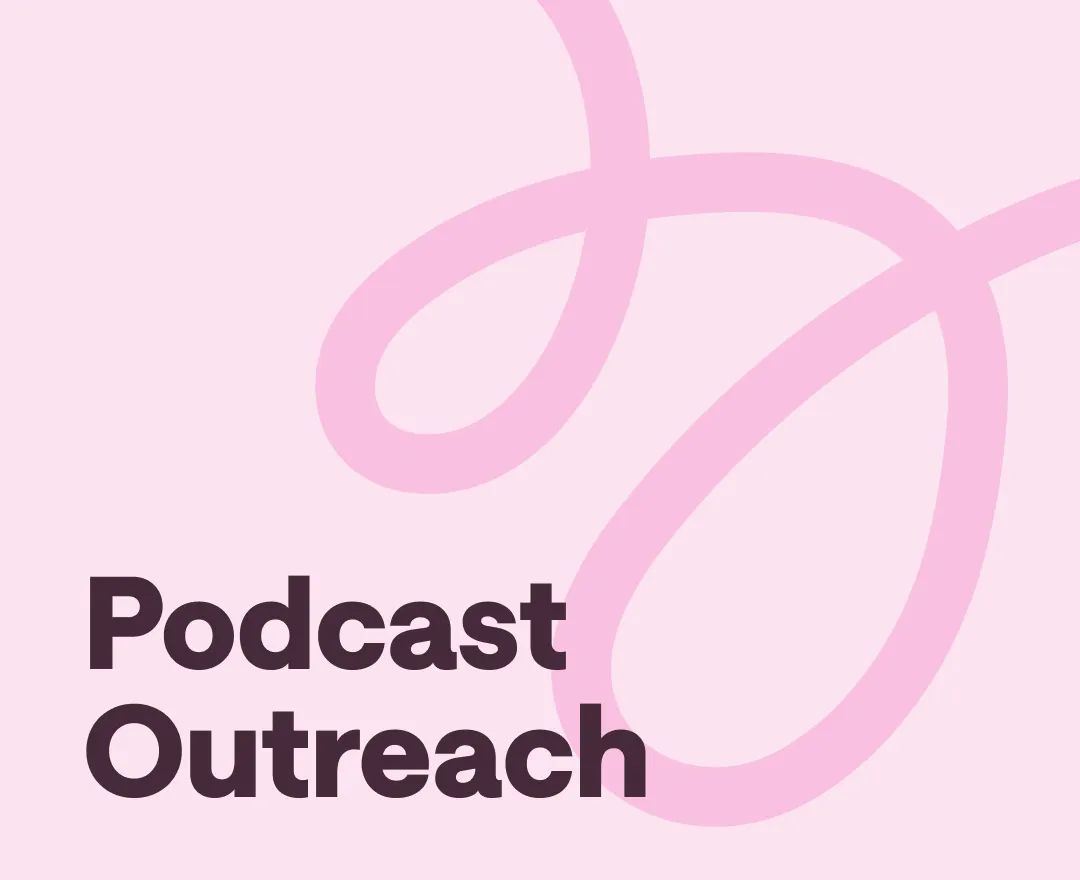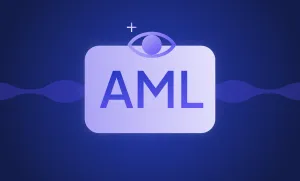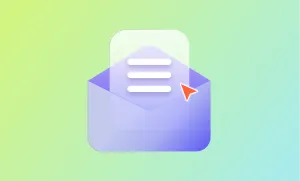Podcasts are an excellent medium to grow your brand. By bringing on guests, you’ll also have access to their audience and network, accelerating your growth even further.
Podcast outreach is the best way to secure high-quality guests on your podcast. You can reach out directly to someone who is a perfect fit, explain why it’s worth their time, and explain the next steps.
In this guide, I’ll show you what podcast outreach is, and the six-step process you can follow to run successful outreach yourself.
Let’s dive in.
What is Podcast Outreach?
Podcast outreach is the process of reaching out to people who would make good potential guests on your podcast.
Even if your podcast has inbound interest, using outreach is the best way to connect with people who you know will be an amazing guest and who might not reach out to you first.
Your outreach process will be designed to start conversations with those potential guests, pitch them on the benefits of joining, and eventually, book them as a guest on your podcast.
Next, I’ll show you a step-by-step process you can follow to run this process effectively.
Step-by-Step Process for Effective Podcast Outreach
Step 1: Narrow Your Focus
Before running any podcast outreach, you need to know who your ideal guests are.
- Do they have a certain job title?
- Do they work in a particular industry?
- Have they had specific past experiences?
- Do they have interest or expertise in the topic of your podcast?
The better you can define your ideal podcast guest, the easier it will be to find guests matching your criteria, and the more you can personalize your outreach pitch.
As well as that, it helps to set a goal for your campaign.
For example, if your goal is to book ten guests, you can then work backwards to figure out what you’ll need to do to get there.
That might mean sending 100 cold emails with a 20% reply rate, and having ten positive conversations. Or, depending on your email-to-podcast booking conversion rate, you might need to reach out to more or fewer people.
Having a goal will also help you evaluate the success of your podcast outreach, which is key.
Step 2: Build a List of Potential Podcast Guests
First, you’ll need to build a list of guests.
Create a new Google Sheet or Excel spreadsheet and add columns for any data you may want to reference:
1) Name
2) Company
3) Email address
4) Job title
5) City
6) An opening line or personalized icebreaker
This will keep you organized, and when it’s time to send your podcast outreach emails, you can insert any fields from the spreadsheet into an email template.
Depending on your industry, there may be different methods to source potential podcast guests. However, most people will see success using:
1) Social media prospecting on channels like LinkedIn and Twitter
2) B2B data platforms like UpLead or ZoomInfo
Social media prospecting on LinkedIn has become increasingly popular among businesses and professionals, with tools such as Linked Helper providing valuable assistance in automating tasks and optimizing outreach strategies.
You can also look for similar podcasts to yours, then identify guests and speakers who have been featured and would be a good fit for your podcast. Looking for guests on similar podcasts works well because you know the person is open to podcast appearances before even reaching out to them.
Most B2B data platforms will automatically show a prospect’s business email address.
Source: UpLead on G2
If their email address isn’t in there, you can export it using Sales Navigator if they have a LinkedIn profile. You can also send them a contact request on LinkedIn using LinkedIn automation.
From there, you’ll need to verify their email addresses to ensure they’re valid.
Once you have a list of potential guests complete with email addresses – aim for 50 to 100 on your initial list – it’s time to craft your first outreach email.
Step 3: Craft a Compelling Outreach Email
Once you know who you’re reaching out to, it’s time to craft your outreach email.
There are several key ingredients here:
1) A personalized introduction that shows you’re only reaching out to that person and haven’t added them to a list with thousands of other people.
2) A clear intention behind your email so they know why you’re reaching out. This matters because you’ll need to quickly show why your podcast is relevant to them.
3) Social proof that shows why replying is worth their time and quickly builds trust. This could be a list of past guests, or the number of listeners you have.
4) A call-to-action that’s simple and makes it easy to respond.
5) Personalization throughout the email that helps it stand out in their inbox.
Check out this podcast outreach email example from The Top:
It does several things well.
1) It instantly opens up with a personalized reference to SaaS companies and uses both the recipient’s first name and company names. Your recipient will instantly see that this email is relevant, assuming they match the criteria.
2) Then, it references two well-known companies as social proof.
3) The call-to-action is simple and makes it easy to reply with a ‘Yes’ and open up a conversation.
Your emails don’t need to be complicated. The easier it is for your recipient to understand and evaluate the opportunity, the more likely they will respond positively.
Following these tips for your cold email structure will get you ahead of the majority of other people running outreach campaigns and give you the best chance of booking more guests.
But, what if someone doesn’t reply? That’s where follow-ups come in.
Step 4: Remember to Follow Up
After running the numbers on millions of cold email campaigns sent with QuickMail, we found that over half of replies come from a follow-up step.
Most of your recipients will see your email, but if they’re busy or have other priorities, they won’t always respond immediately.
A friendly reminder email is a powerful way to get your email back to the top of your recipients’ inboxes and give you another chance to show why it’s worth starting a conversation with you.
Your follow-up email shouldn't be too pushy. It should re-frame your pitch and the benefits for your recipient and simply remind them that you’re there and reaching out.
Here are some of the best tips for improving replies from follow-up emails:
- Wait three days before following up with someone.
- Include three to five follow-up steps in your campaign sequence.
- Add new social proof that may be more enticing to them.
- Use a new call-to-action in case the first one was too high of a commitment. For example, ask if it’s something they’re interested in, instead of asking them for a 15-minute call.
You can use a sales engagement platform like QuickMail to automatically add follow-up steps to your podcast outreach campaign.
If someone doesn’t reply, they’ll automatically receive your follow-up email after a delay of your choice.
You’ll get more replies, and ultimately, book more guests on your podcast.
Step 5: Consider Using Multichannel Outreach
Email is the best channel to reach busy decision-makers.
But, if you’re not getting replies from people who you think would be interested in being a guest, then you can test other channels.
Other channels you can consider include:
1) Running LinkedIn outreach campaigns and use personalized InMail
2) Using Twitter to send personalized direct messages
3) Joining private communities where your ideal guests spend time and ask there
The better that you understand your ideal guests, the easier it will be to find where they spend time online, and get in touch with them there.
You could also use these in tandem with your email outreach. A multichannel outreach strategy can give you more opportunities to get noticed, and means you won’t risk having any blind spots.
Step 6: Tracking Your Outreach Results
Reporting is key to any good marketing campaign, and it’s no different with podcast outreach. It’s vital that you know your podcast outreach metrics.
If you can predict how many guests you’ll book based on how many emails you send, it’ll be easy to plan ahead.
The easiest way to track these is in your cold email software.
For example, QuickMail gives you data on metrics like:
1) Open rate
2) Click-through rate
3) Reply rate
4) Unsubscribe rate
5) Bounce rate
Once a campaign is running, you’ll see your metrics updating live and can quickly assess whether or not the results are on par with what you were expecting.
If they’re not, you can then update and optimize your campaign before sending any more outreach emails.
After a campaign is finished, you’ll have all of the data you need to judge success and decide if it’s worth doing again in the future.
Conclusion
Podcast outreach is a powerful way to connect with potential guests, start conversations, and book meetings.
The goal of all outreach is to get your recipient talking – not instantly book them as a guest. Once someone shows interest, you can explain the benefits of being a guest to them, and let them decide if they want to participate.
The best practices and steps we’ve looked at will give you a clear path to follow.
When you’re ready to start sending cold podcast outreach, make sure to let us know how it goes!








